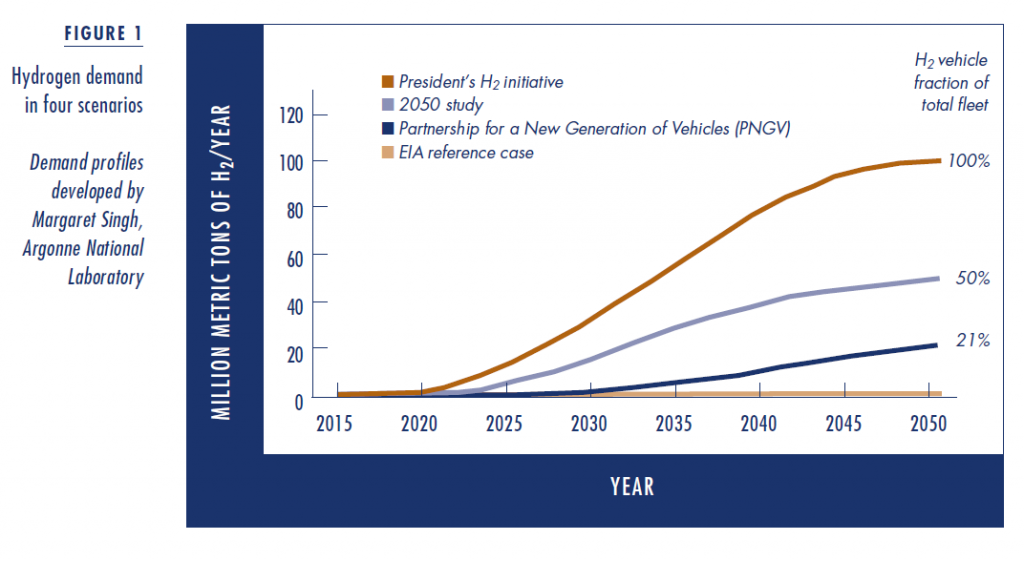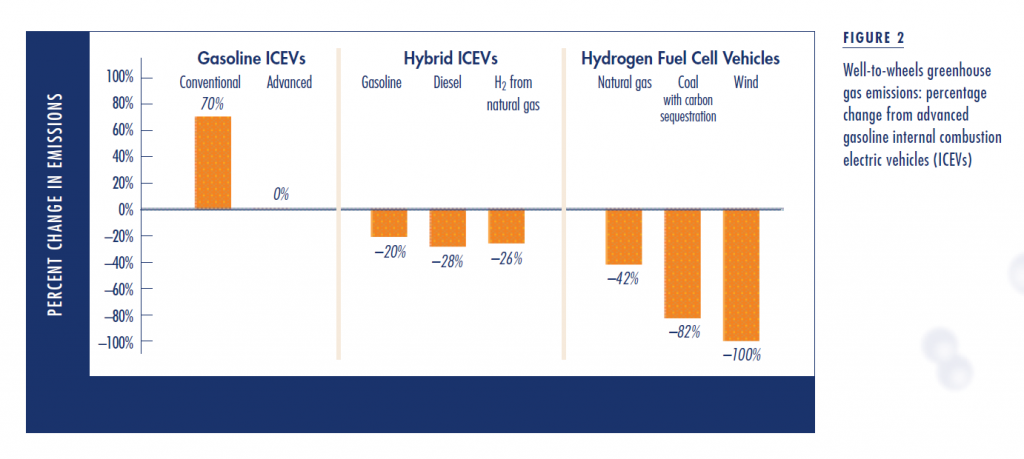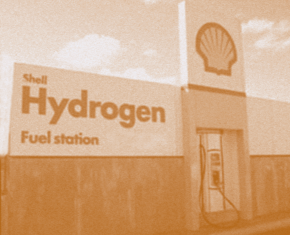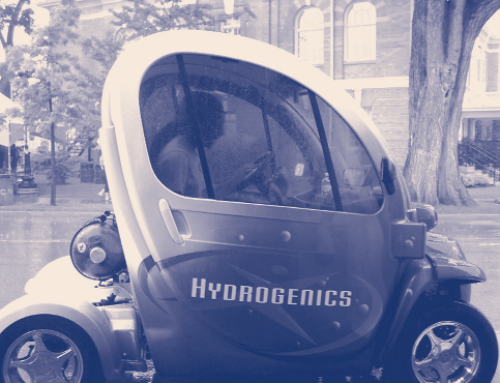[sharelines]Hydrogen could revolutionize transportation fuel but needs greater support to see widespread adoption.
Of all alternatives to gasoline fuels, hydrogen offers the greatest long-term potential to radically reduce many problems inherent in transportation fuel use. For example, hydrogen could enhance energy security and reduce dependence on imported oil, since it can be made from various primary energy sources, including natural gas, coal, biomass, and wastes, and from solar, wind, hydro, geothermal, and nuclear energy. Also, hydrogen vehicles have zero tailpipe emissions and are very efficient. If it is made from renewable sources, nuclear power, or fossil sources with carbon emissions captured and sequestered, hydrogen use on a global scale could produce nearly zero greenhouse gas emissions and greatly reduce emissions of air pollutants.
Fuel Of The Future
 Most analysts believe that hydrogen will become a major fuel only if it has very strong support from aggressive public policy aimed at solving these larger problems of energy security and pollution. On the other hand, some suggest that hydrogen and the fuel cells that use it to produce electricity could make possible other developments— such as clean, quiet, mobile electricity generation—that would make them attractive to consumers, and therefore marketable, even without aggressive policy support. Some call hydrogen and fuel cells “disruptive technologies” because they could change how we produce and use energy in profound ways.
Most analysts believe that hydrogen will become a major fuel only if it has very strong support from aggressive public policy aimed at solving these larger problems of energy security and pollution. On the other hand, some suggest that hydrogen and the fuel cells that use it to produce electricity could make possible other developments— such as clean, quiet, mobile electricity generation—that would make them attractive to consumers, and therefore marketable, even without aggressive policy support. Some call hydrogen and fuel cells “disruptive technologies” because they could change how we produce and use energy in profound ways.
But hydrogen also poses the greatest challenges of any alternative fuel. Complex technical, economic, and infrastructure problems must be resolved before it can be used on a large scale. Refining and chemical industries already produce, store, and distribute hydrogen, but the technologies they use need to be adapted for wider use. Building a new hydrogen distribution infrastructure will be expensive and complicated and require solutions to complex logistical problems such as matching supply and demand during a transition. Today, about 95 percent of hydrogen is made from fossil fuels, so although it’s a “clean” fuel when used, its manufacture produces emissions. To realize hydrogen’s benefits fully, production methods that produce no emissions are needed. And although fuel cells and zero-emission hydrogen production systems are progressing rapidly, technical and cost issues must be resolved before they can compete with current fuel technologies.
There remain many questions surrounding a transition to hydrogen. How soon will markets for hydrogen vehicles develop? How will the hydrogen be produced? How will society benefit? How much will it cost to build a hydrogen infrastructure? How soon could hydrogen make a difference in energy use, greenhouse gas emissions, and pollution?
Perhaps the most important question is: what should we do now? Hydrogen has great long-term promise, but implementation will take time and is surrounded by uncertainties. I want to discuss transition issues and their large uncertainties, then suggest near- to mid-term “no-regrets” actions we can take now.
Demand
It is not possible to predict future hydrogen demand accurately. Performance and cost of hydrogen vehicles versus competitors is uncertain, as is the future policy landscape. Figure 1 shows four scenarios developed by the USDOE, wherein the market fraction of hydrogen projected for 2050 ranges from 1 percent to 100 percent.
 Hydrogen vehicles will not become a commercial product for at least five to ten years. Once they are introduced, it will take time to capture market share and for the existing fleet to retire. Even under the most aggressive scenario, it is unlikely that hydrogen vehicles will constitute more than a few percent of the total fleet by 2025. However, the portion could grow rapidly beyond then. How will we meet this future demand?
Hydrogen vehicles will not become a commercial product for at least five to ten years. Once they are introduced, it will take time to capture market share and for the existing fleet to retire. Even under the most aggressive scenario, it is unlikely that hydrogen vehicles will constitute more than a few percent of the total fleet by 2025. However, the portion could grow rapidly beyond then. How will we meet this future demand?
Supply
Hydrogen is the most common element in the universe, but on earth it is bound up in chemical compounds such as water (H2O) or hydrocarbons (fossil fuels or plants). It takes equipment and energy to extract hydrogen from these sources. Hydrogen can be made by electrolysis, which uses electricity to split water molecules into hydrogen and oxygen, or by thermochemical methods that use heat to break down hydrocarbons and separate the hydrogen. Hydrogen can then be stored as a compressed gas at high pressure or as a super-cold liquid (at –253 C), both of which pose infrastructure challenges in terms of storage and delivery to consumers. Hydrogen can be burned in special engines or used in fuel cells, which combine hydrogen and oxygen to produce electricity.
 The environmental or energy security benefits we might achieve by using hydrogen vary depending on which primary source produces it and which production method is used. Every stage from well to wheels—from extracting primary resources through manufacturing, distributing, and using a fuel—can produce emissions, and all emissions must be taken into account when adding up the benefits of hydrogen or any fuel. Figure 2 compares well-to-wheels greenhouse gas (GHG) emissions for several alternative-fuel vehicles, including hydrogen from various sources.
The environmental or energy security benefits we might achieve by using hydrogen vary depending on which primary source produces it and which production method is used. Every stage from well to wheels—from extracting primary resources through manufacturing, distributing, and using a fuel—can produce emissions, and all emissions must be taken into account when adding up the benefits of hydrogen or any fuel. Figure 2 compares well-to-wheels greenhouse gas (GHG) emissions for several alternative-fuel vehicles, including hydrogen from various sources.
First Steps: Hydrogen Supply During A Transition
Currently, most hydrogen in the United States is made from natural gas, which is generally cheaper than other sources. It is widely seen as the most likely choice for a transitional source of hydrogen production in the United States in the next few decades. Hydrogen from natural gas has a modest well-to-wheels GHG benefit compared to liquid fossil fuels in improved internal combustion engine (ICE) hybrid electric vehicles. Using natural-gas hydrogen would also reduce air pollutant emissions and oil use, although expanded natural gas use in the United States might eventually require importing it, bringing new security issues. However, over the next decade or so there wouldn’t be enough hydrogen vehicles to have more than a small effect on the US natural gas supply. Even under the most optimistic hydrogen-demand scenarios, natural gas use would increase only a few percent by 2025.
Future Resource Issues
It is imperative to develop hydrogen sources that produce very low GHG emissions. Renewables, fossil fuel combined with carbon sequestration, and nuclear energy are all possible sources and can be widely available. But challenges face each of these zero-emission hydrogen supply pathways.
For renewables, the issue is primarily cost rather than technical feasibility. Electrolyzers using solar, wind, hydro, or geothermal power could be built today, but, in the United States, the resulting hydrogen would generally cost more than current methods using natural gas. To derive hydrogen from biomass, very large areas of land are necessary to grow enough feedstock, and competition from the electricity sector for low-cost biomass could drive up prices and further limit availability.
Hydrogen made with nuclear energy can be expensive, unless cheaper off-peak power is used. Thermochemical water-splitting systems powered by nuclear heat are still in the laboratory stage and a number of technical issues must be resolved before they can be built. Also, nuclear hydrogen would have the same waste disposal and proliferation issues as nuclear electricity.
Producing hydrogen from fossil sources (coal) using carbon capture and sequestration is receiving considerable attention worldwide as a way of making fuel from coal with near-zero GHG emissions. (With sequestration, carbon is “captured” chemically during hydrogen production and injected into deep underground geological reservoirs for permanent storage.) This approach holds the promise of nearly zero emissions and relatively low cost, assuming that close, suitable carbon disposal sites are available and that hydrogen is produced on a large scale. However, much remains unknown about the potential environmental impacts and feasibility of this method.
 There are ample primary resources for hydrogen production in the United States and in most areas of the world. Figure 3 shows primary energy requirements to fuel 100 million hydrogen vehicles (about half the number of light duty vehicles in the United States today), assuming these vehicles are two to three times as efficient as today’s twenty- to thirty-mile-per-gallon gasoline vehicles. There are clearly many resources that could contribute to hydrogen production in the United States in the near term and the long term, including renewable resources and fossil resources with carbon sequestration. Diverse resources might be used in a future hydrogen system (similar to today’s electricity supply), so envisioning the evolution of a future hydrogen supply infrastructure is complex and regionally specific.
There are ample primary resources for hydrogen production in the United States and in most areas of the world. Figure 3 shows primary energy requirements to fuel 100 million hydrogen vehicles (about half the number of light duty vehicles in the United States today), assuming these vehicles are two to three times as efficient as today’s twenty- to thirty-mile-per-gallon gasoline vehicles. There are clearly many resources that could contribute to hydrogen production in the United States in the near term and the long term, including renewable resources and fossil resources with carbon sequestration. Diverse resources might be used in a future hydrogen system (similar to today’s electricity supply), so envisioning the evolution of a future hydrogen supply infrastructure is complex and regionally specific.
Costs And Timelines
A mature hydrogen refueling infrastructure might cost several hundred to several thousand dollars per vehicle served, depending on the type of supply. Near-term costs would be higher, but they would decrease with experience and as the number of hydrogen vehicles increased. Shell Oil Company recently estimated that an initial nationwide network of 11,000 hydrogen stations in cities and along interstate highways would cost about $12 billion. Full implementation in the US (serving 100 million hydrogen vehicles) might cost hundreds of billions of dollars over a period of several decades.  Although these are huge costs, they are of the same order of magnitude as the investment costs of expanding and maintaining the infrastructure for conventional transportation fuels. In other words, we’d have to spend this much anyway.
Although these are huge costs, they are of the same order of magnitude as the investment costs of expanding and maintaining the infrastructure for conventional transportation fuels. In other words, we’d have to spend this much anyway.
Once a hydrogen infrastructure is well established, the delivered cost of hydrogen at the pump is likely to be $2.50 to $4 per kilogram ($1/kg hydrogen is comparable to $1/gallon gasoline). Given that hydrogen vehicles might be two to three times as efficient as today’s gasoline cars, the fuel cost per mile could turn out to be less than for current gasoline vehicles.
Even under a scenario of technical success and strong policy, it will be ten to fifteen years before hydrogen energy technologies enter mass markets. Most analysts do not see hydrogen playing a major role in reducing emissions or oil use for several decades. (Local benefits might be felt before this, if hydrogen is used in fleet vehicles in cities, for example.) After 2025, however, hydrogen could help greatly reduce emissions and oil use.
The Debate About Hydrogen: What Now?
There is relatively little dispute that hydrogen is one of very few long-term fuel options that allow radical reductions in greenhouse gases, air pollutants, and oil use. However, there is considerable debate about near-term priorities. Some analysts assert that current support for hydrogen hurts other efforts to reduce carbon emissions in the near term by diverting resources away from them. Is pursuing a long-term option that will not make much difference before 2025 a good strategy? Couldn’t focusing on improved energy efficient technologies, such as gasoline hybrids, solve problems now?
 Many effective approaches (such as higher efficiency vehicles), should be pursued simultaneously, both to address energy-related problems in the near term and to drive a long-term shift towards low-carbon fuels such as hydrogen. Policies that encourage energy efficiency need not compete with RD&D (Research, Development, and Demonstration) on hydrogen; indeed, the two parallel efforts complement each other. Many of the technologies needed for hybrid vehicles will also be used in fuel cell vehicles. Low-carbon technologies such as wind power, biomass, or carbon sequestration being developed for the electricity sector could be important for hydrogen as well.
Many effective approaches (such as higher efficiency vehicles), should be pursued simultaneously, both to address energy-related problems in the near term and to drive a long-term shift towards low-carbon fuels such as hydrogen. Policies that encourage energy efficiency need not compete with RD&D (Research, Development, and Demonstration) on hydrogen; indeed, the two parallel efforts complement each other. Many of the technologies needed for hybrid vehicles will also be used in fuel cell vehicles. Low-carbon technologies such as wind power, biomass, or carbon sequestration being developed for the electricity sector could be important for hydrogen as well.
A comprehensive approach should include both, as near-term and long-term strategies. Relying exclusively on vehicle energy efficiency to bring down carbon emissions will not be enough in the long run. Even with efficiency improvements, the growing number of vehicles alone will increase carbon emissions from transportation unless we reduce the carbon content of fuel.
Large-scale use of hydrogen in transportation is not a foregone conclusion, but a vigorous program of hydrogen RD&D is a prudent insurance policy against the need to begin radical decarbonization of other fuels within a few decades, while simultaneously addressing energy security and pollution problems. Given the promise of hydrogen, its long time frame, and its challenges, it is important to provide significant support now, so that hydrogen technologies and strategies will be ready when needed.
A No-Regrets Action Agenda
The following actions can and should be pursued over the next decade or so, and would provide benefits no matter what form the future energy system takes.
Hydrogen-specific actions over the next decade
- Government and industry should offer strong support of RD&D on hydrogen technologies, especially fuel cells, zero-emission hydrogen production (including hydrogen from renewables and research on carbon sequestration), and hydrogen storage.
- Public/private partnerships should bring all stakeholders together to demonstrate hydrogen technologies. The California Fuel Cell Partnership, the US Department of Energy’s FreedomCAR hydrogen program, and the United Nations Development.
- Program demonstrations of fuel cell buses are examples of efforts already underway, and other regional public/private partnerships are under development worldwide.
- Federal and state governments should use hydrogen technologies in government buildings and vehicle fleets soon—over the next five to ten years.
- Codes and standards for safe hydrogen operation must be established. Thus far, national and international standards organizations, industry representatives, and professional societies have been developing standards with support from the United States and other governments.
- Government, academic, and industry researchers must conduct analyses to better understand external energy costs, energy alternatives, and the role of hydrogen in future energy systems. As noted above, not all hydrogen production methods are equal in terms of greenhouse gases, air pollutants, primary resources, nor implications for security.
General Actions over the next ten to twenty years
- Develop consistent national energy policy addressing climate change, air pollution, and national security. Such a policy should outline near-term actions to address these problems now (such as support for energy efficiency and hybrid vehicles), as well as simultaneous actions to develop hydrogen and other technologies that in the long term could produce deep cuts in carbon emissions.
- Conduct RD&D on a wide range of energy-efficient technologies, including hydrogen vehicles, electric drive-train components for hybrid vehicles, and advanced lightweight materials.
- Conduct RD&D on clean-energy technologies with applications in both electricity and hydrogen production, including wind, solar, and gasification technologies, carbon sequestration, and biomass energy.
Conclusion
Hydrogen has the potential to become an important part of a future transportation system with diverse supply and low emissions. A consistent federal energy policy is urgently needed to enable a progression of clean transportation technologies, starting with efficiency and hybrids now, and moving toward efficient use of low carbon fuels like hydrogen in the longer term. Many of the energy technologies mentioned here are undergoing R&D now, but the overall level of government support for energy R&D is much less than is warranted by the seriousness of the problems, and indeed is much less than other industries such as electronics or pharmaceuticals. Hydrogen is a key option that we should nurture as part of a broader science, technology, and policy initiative.
Further Readings
Robert M. Margolis and Dan Kammen, “Underinvestment: The Energy Technology and R&D Policy Challenge,” Science, vol. 285, issue 5428, 690–692, 30 July 1999.
National Academy of Engineering, The Hydrogen Economy: Opportunities, Costs, Barriers, and R&D Needs (Washington, DC: National Academies Press, 2004).
Joan Ogden, “Prospects for Building a Hydrogen Energy Infrastructure,” Annual Review of Energy and the Environment, vol. 24, pp. 227–279, 1999.
Daniel Sperling and James S. Cannon. The Hydrogen Energy Transition: Moving Toward the Post Petroleum Age in Transportation (Burlington, MA: Elsevier Academic Press, 2004).
United States Department of Energy, National Hydrogen Energy Roadmap, November 2002.






